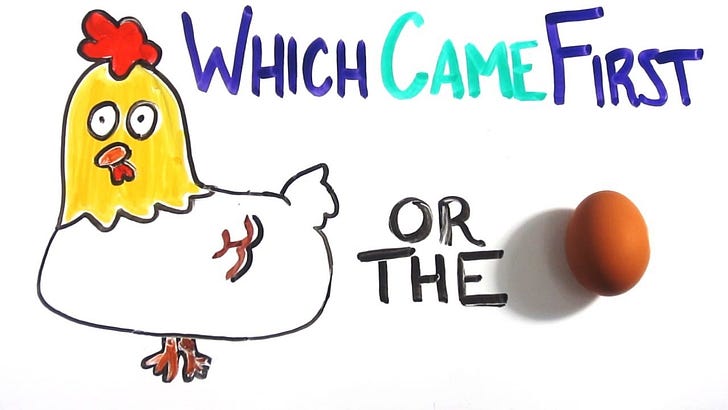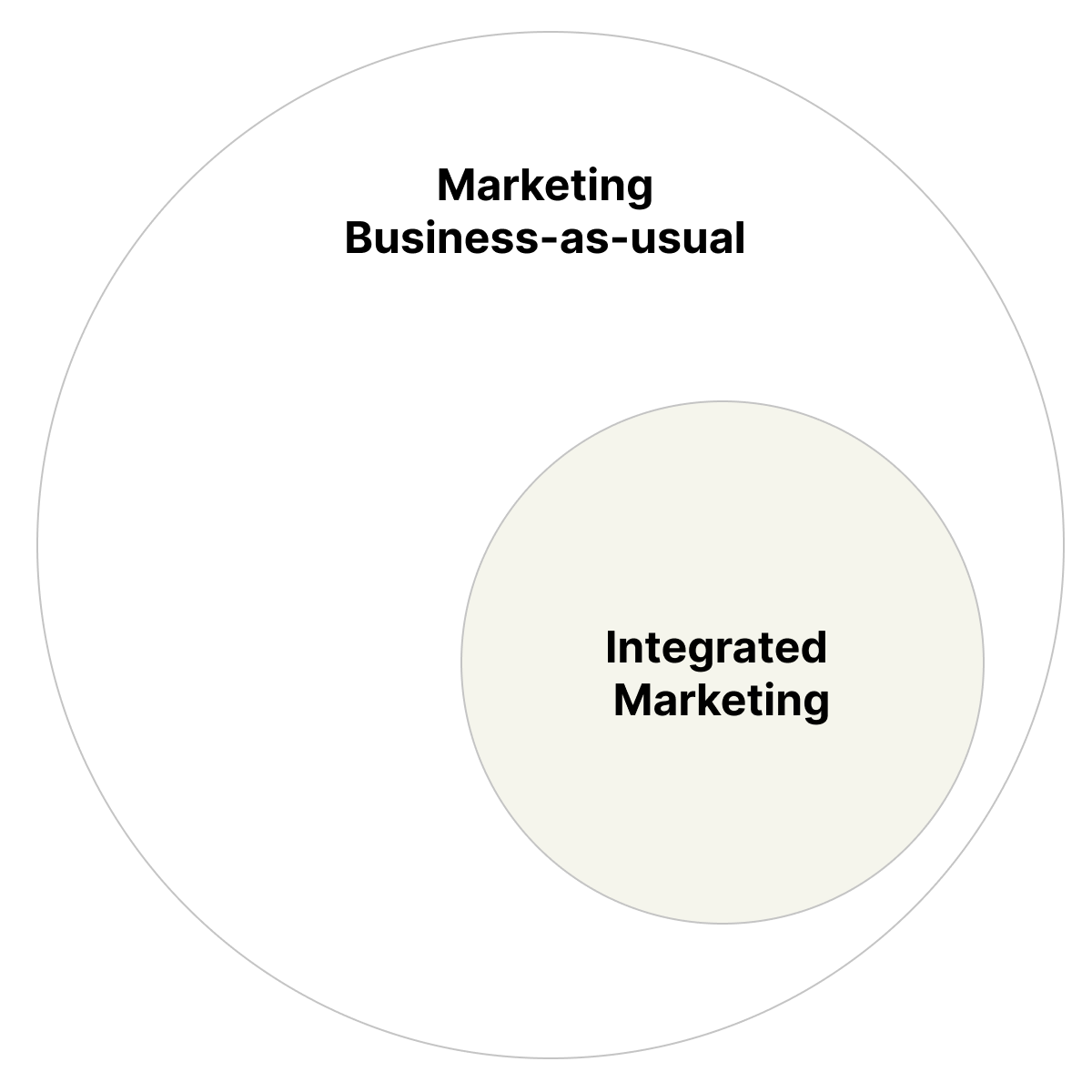Hi there 👋
How do you do your team standups? I’m considering writing a newsletter in the upcoming weeks about how I run these meetings, and I would love your input. I’m always interested in ways to improve (team meetings are an expensive use of time!). For instance, I’m looking into tools like Grain to record and edit video meetings for faster async consumption afterward for those who missed them. Any feedback and ideas are welcome!
Wishing you a great week ahead,
Kevan
(ᵔᴥᵔ)
P.S. I’ve included some neat remote marketing jobs at the end of this email. Places like Zapier, Webflow, and Loom are hiring. You can check out my remote marketing jobs Airtable here.
Thank you for being part of this newsletter. Each week, I share playbooks, case studies, stories, and links from inside the startup marketing world and my time at Oyster, Buffer, and more.
Say hi anytime at hello@kevanlee.com. I’d love to hear from you.
A Brief Primer on Integrated Marketing
As many of you may recall, I do not come from a traditional marketing background: no MBA, no marketing degree, no formal business education. So a lot of the marketing strategies that I’ve found to be successful have simply been the things that worked best, regardless of whether I knew their names at the time.
Things like Product-Led Growth, SEO historical optimization, and audience marketing arose organically for me. Same with integrated marketing.
Integrated marketing is the practice of aligning your messaging across your marketing channels in order to deliver a consistent experience and high impact.
Sound familiar? To me, it sounds a lot like plain old marketing.
It’s like the chicken or the egg … Which came first: integrated marketing or a holistic multichannel marketing strategy?
Here’s how Mailchimp describes integrated marketing:
The practice of aligning all marketing tactics to the same core messaging for a consistent customer experience with your brand. Through integrated marketing, communications tactics such as display ads, landing pages, email marketing, direct mail marketing, and product catalogs all work in the same direction toward your marketing objectives. One example is making your call to action (CTA) consistent across all online and offline tactics for a particular campaign.
Integrated marketing communications is aligning your marketing channels to promote your products or services in tandem, typically through a strategic campaign. Integrated marketing also works to align the primary brand message that’s being delivered through your marketing channels and assets.
Integrated marketing (sometimes referred to as 360-degree marketing or omnichannel marketing) is the act of creating digital marketing campaigns across multiple channels that all work together and complement each other to reach the same goal.
“Aligning marketing tactics to the same core messaging.”
“Aligning your marketing channels to promote your products or services in tandem.”
“Creating campaigns across multiple channels that all work together.”
If you read these statements and think to yourself, “This sounds like … marketing,” you’re not alone. I often have the same thought. Despite that, at Oyster we’re starting to adopt the name integrated marketing to describe some of our work. For us, it’s become a useful convention for driving better organization and alignment with the way our team works.
Here’s more …
How we think about integrated campaigns at Oyster
1. Integrated campaigns start with a hypothesis
One of the main distinctions between an integrated campaign and business-as-usual marketing work is that integrated campaigns are extremely focused and deliberate in their target persona and channel mix.
Every integrated campaign should aim for a specific persona. And every campaign should aim for the right channels to engage that persona. We talk about this as a hypothesis, for example: If we do X, then we expect Y to happen because of Z data or learnings or precedent. Or, We think X will do Y, and we’ll know if we’ve succeeded if Z happens.
The nearest proxies for integrated campaigns (without actually calling them integrated campaigns) were things like
2. You need a campaign strategist and a campaign manager
To drive the additional focus and discipline of an integrated campaign, you need to dedicate resources to coming up with the strategy and execute on the tactics. For large teams, the strategist and manager can be entire jobs where you’ve hired full-time teammates to run these campaigns. But you can also get by with asking for a “campaign mindset” among your team — for instance, a product marketer makes for a great campaign strategist for every product launch.
The campaign strategist forms the hypothesis, identifying a persona and channel mix using data and insights.
The campaign manager runs the campaign, managing deliverables and following up on performance.
3. Integrated campaigns must be tracked as their own thing
As you can tell from the first two points, integrated campaigns have a great deal of focus. And this extends to the way they are tracked and measured. One of the easiest steps to skip in transitioning to an integrated marketing setup is the measurement. (It’s also one of the hardest bits of infrastructure to build.) Make sure you’ve got at least a basic level of campaign tracking in place via UTMs.
4. You can do more than one integrated campaign at a time
If a campaign is working, there’s no need to turn it off :)
With this mindset, it is possible that you may have multiple campaigns running at the same time. So long as your team has the bandwidth, this can be a boon to your marketing efforts because it creates a strong test-and-learn environment and allows you to invest in what’s working.
5. The goal of a campaign can be anything
Some places might advise you to focus your integrated campaigns on revenue. But I think these campaigns can be pointed at any particular goal: brand awareness, engagement, audience growth, etc.
6. Integrated campaigns are not the only thing we do
Pivoting to work with integrated campaigns is not a wholesale change for all your marketing activities. Integrated marketing is one of the many tools in our marketing toolbox. Along with these campaigns, we still do the business-as-usual activities of always-on workstreams (like SEO content) and there may even be one-off projects that don’t fit neatly into any current campaigns.
Templates:
Product marketing launch template
Misc.
Remote jobs
Zapier is hiring a Head of Product Marketing (plus 10 other roles)
Webflow is hiring an SEO Lead (plus 8 other roles)
Postscript is hiring a Technical Partner Manager
Mixmax is hiring a Product Marketing Manager
Mozilla is hiring a Product Marketing Manager, Innovation
Loom is hiring a Strategic Marketing Manager
Interesting articles
How to become a content marketer without a marketing background (this was my path, too)
About this newsletter …
Hi, I’m Kevan, a marketing exec based in Boise, Idaho, who specializes in startup marketing and brand-building. I currently lead the marketing team at Oyster (we’re hiring!). I previously built brands at Buffer, Vox, and Polly. Each week, I share playbooks, case studies, stories, and links from inside the startup marketing world. Not yet subscribed? No worries. You can check out the archive, or sign up below:
Thank you for being here! 🙇♂️
I’m lucky to count folks from great brands like these (and many more) as part of this newsletter community.







